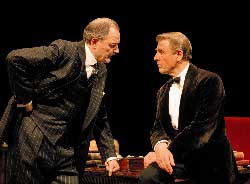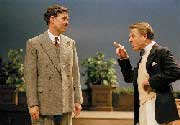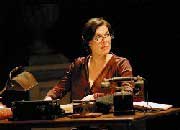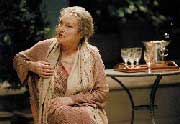

|
| The Old Masters (2004) Birmingham Repertory Theatre, Birmingham, UK Comedy Theatre, London, UK |
||||||||||
Directed by Harold Pinter Set Design by Eileen Diss Costume Design by Dany Everett Lighting Design by Mick Hughes Cast:- Edward Fox as Bernard Berenson Peter Bowles as Duveen Barbara Jefford as Mary Sally Dexter as Nicky Steven Pacey as Fowles Reveiw - Daily Telegraph - Friday 2nd July 2004 OLD MASTERS IN THEIR PRIME The Old Masters is written by Simon Gray, directed by Harold Pinter, and stars two of Britain's most cherishable senior actors, Edward Fox and Peter Bowles. A few years ago, it would have been a sure fire hit.
The action is set in 1937, at I Tatti, the beautiful villa outside Florence owned by the celebrated art historian Bernard Berenson, living in a ménage á trios with his ailing wife Mary and his devoted secretary Nicky. Berenson is beginning to feel the financial pinch of owning such a splendid home, and regards the rise to power of Mussolini, whom he calls the Duck, with fear and loathing. The barbarians are all too evidently at the gates, threatening the civilisation to which Berenson has devoted his life. Then Joseph Duveen, the powerful and flamboyant art dealer, arrives. He has had a turbulent relationship with Berenson for many years and has brought a painting with him, a picture of the adoration of the shepherds at Christ's nativity. The problem is that Berenson insists that it is by Titian, while Duveen is desperate for him to authenticate it as a rare Giorgione, which will vastly increase its price.
The meat of the play consists of a marvellous central scene, straddling both sides of the interval, in which the devious Duveen attempts to bend Berenson to his will in a splendidly absorbing game of cat-and-mouse, in which you are never quite sure who is the cat and who the mouse. Better still, Bowles and Fox are at the very top of their game. Some will doubtless complain that Fox is nothing like Berenson, a Lithuanian Jew who moved to America at the age of 10. Is it likely that such a man would speak like a magnificently eccentric English aristocrat from the novels of PG Wodehouse? No it isn't.
Personally, however, I can never get enough of this unique and extravagantly mannered actor, and what the performance lacks in authenticity, it certainly makes up for in preposterous entertainment value. Nor does Peter Bowles allow himself to be daunted by such delicious hammery. Arriving in an astrakhan-collared coat like an actor-laddie of old, he performs his patented old-smoothie-with-just-a-hint-of-menace routine with all his familiar suave aplomb. Watching this pair playing against each other with such cunning is a joy.
In the final analysis, the piece is less illuminating about art, less touching in its account of human love, than one might have hoped. See it for Fox and Bowles, two wily old masters in their prime. By Charles Spencer |
||||||||||
| Back to Directing main page |




